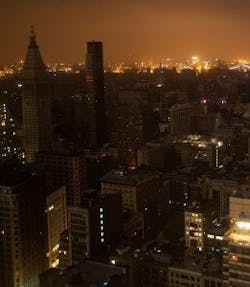A dark Manhattan after Superstorm Sandy. Credit: Kevin Deamandel
What’s it worth to society to avoid a power outage? The question nags the microgrid industry. Not knowing makes it hard to monetize microgrids.
As it stands now, grid-connected microgrids provide uncompensated services, chief among them the guarantee that electricity will continue to flow when the central grid fails.
The ability to avert an outage is not something that’s easy to price; in fact, it is complicated enough that someone could do a whole doctoral thesis on it — and someone is.
Andrea Ruótolo, a Fulbright PhD candidate at the University of Delaware’s Center for Energy and Environmental Policy, is working on a dissertation that explores the cost/benefit analysis of microgrids, taking into account social and environmental metrics.
Ruótolo spoke earlier this month about New York’s microgrid activities at the Third National Microgrid Conference in Dallas, Texas, sponsored by S&C Electric and Schneider Electric. We caught up with Ruótolo later to learn more about her work.
Society tends to discount the value of a microgrid until after a natural disaster, she said. Then suddenly we understand the harm of a prolonged outage. In fact, today’s boom in microgrid projects can be traced back to SuperStorm Sandy.
And while we are now building microgrids in the Northeast and many other states, we have no real way to translate into dollars and cents all that they bring to the grid, the community, or the environment — locally, regionally and globally. “All of these complexities, we have not been able to address,” she said.
That’s where Ruótolo’s work comes into play.
Formulas do already exist, many developed in Germany, which try to describe the social and environmental externalities that microgrids avert. Ruótolo is gathering the formulas and running metrics to determine the certainty of various outcomes.
She hopes the results can help policymakers and regulators put a monetary value on what microgrids bring to the electric system — those who are willing, that is, to consider their worth. At this point, only a handful of states are having the discussion. Ruótolo is confident others will come around, one way or the other.
“I think that through community pressure, national pressure…we will open up more eyes that externalities have to be incorporated,” she said.
Meanwhile, Ruótolo also is deeply involved in New York’s push to create a more distributed grid, one that is likely to accommodate more microgrids. She serves as senior project manager at the New York State Smart Grid Consortium, a public-private partnership closely involved with Reforming the Energy Vision, as well as the NY Prize.
While the Third National Microgrid Conference featured several expert speakers like Ruótolo, the real star of the show was the new Oncor microgrid. The conference included a tour of the facility, which is billed as the most advanced microgrid in the United States. Not one microgrid exactly, but four working together (or apart), it offers a first-of-a-kind automation and sophistication.
MicrogridKnowledge.com wrote about the Oncor microgrid here. But we picked up a few additional interesting side notes during the tour:
- Initially Oncor planned to explore energy storage. But after deciding to add a few solar panels, the team kept going and built an entire microgrid.
- The utility wanted the project to replicate the real-world environment and circumstances in Oncor’s territory. For that reason the microgrid includes solar, energy storage, a gas fired microturbine and electric vehicle charging station.
- At some point, Oncor plans to add wind turbines to the microgrid.
- Oncor intentionally brought in many different microgrid players to see how different companies and platforms integrate into one unified system.
- The project is a research and learning facility. To that end, Oncor is inviting other utilities to visit the site and learn from it.
Save the date: the Forth National Microgrid Conference will be held April 13-15, 2016 in Kansas City, Missouri. You can learn more about upcoming microgrid conferences on the Microgrid Knowledge Events Calendar.
To get a free copy of the Oncor Case study visit Schneider Electric’ Microgrid resource library.
About the Author
Elisa Wood
Editor-in-Chief
Elisa Wood is the editor and founder of EnergyChangemakers.com. She is co-founder and former editor of Microgrid Knowledge.
